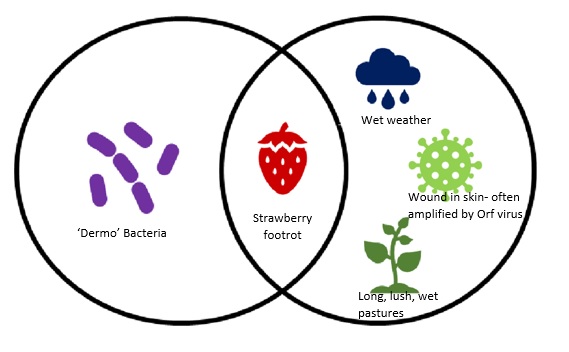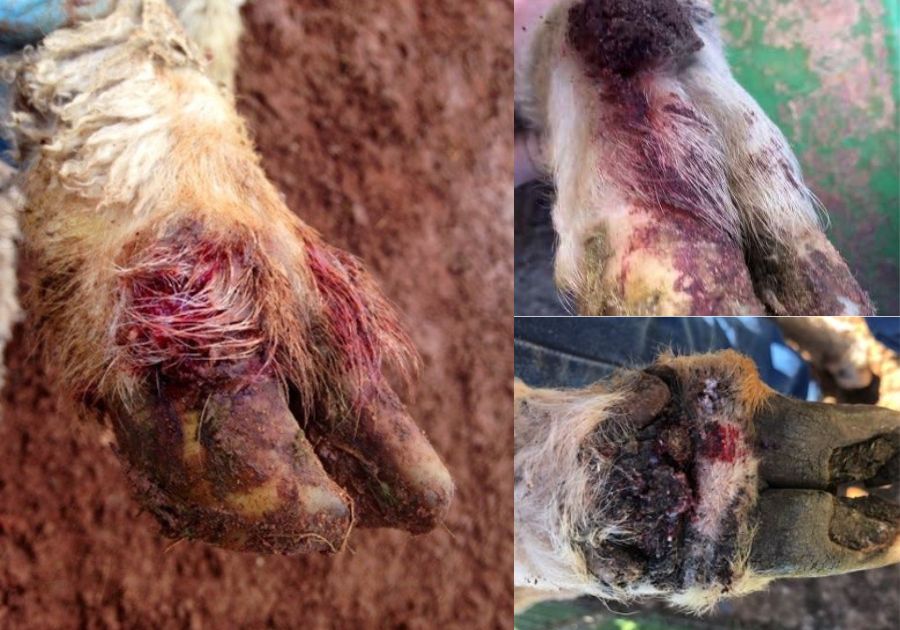Strawberry Footrot
Despite the name, Strawberry Footrot is very different from virulent footrot. It is a disease that is caused by a combination of bacterial and viral infection which produces lesions around the feet and mouth, and is a common cause of lameness in sheep. Affected stock may be reluctant to walk and have severe, localised swelling, often extending up the leg.
The viral component of the disease is zoonotic (contagious to humans). Wearing gloves and other appropriate personal protective equipment when handling sheep with suspicious wounds is recommended.
What causes Strawberry Footrot?
Strawberry footrot is caused by a combination of the bacteria Dermatophilus congolensis (the same bacterium that causes lumpy wool) and the parapox virus. Dermo bacteria occur normally on sheep and are generally impossible to eliminate from the flock. The bacteria itself causes no issue unless given the right environment for infection, ie. moist conditions, and lush wet spring pastures around the feet of sheep.

When to watch for Strawberry Footrot?
Prolonged wet weather and the undue stress it places on young stock are key factors in the appearance of Strawberry Footrot.
All ages and sheep breeds are susceptible but lambs, weaners and hoggets are most commonly affected. Stressed, young stock are highly susceptible to infection, typically during seasons of prolonged wet weather.
Recent movements, mixing of mobs and confinement often increase the number of animals affected by the disease.
Clinical signs of Strawberry Footrot in sheep
- Scabs generally appear on the legs between the foot up to the knee or hock, along with hair loss.
- Stock may have reduced mobility and severe localised swelling often extending up the leg.
- Scab removal reveals a bleeding and fleshy mass.
- Lameness can occur when the lesions are thick, when they break causing the skin to split, or if lesions occur in the interdigital space.
Strawberry Footrot has a similar appearance to the lesions produced by the Orf virus, however the legions are localised to the feet and coronet. It is very important that an accurate diagnosis is made so that appropriate treatment can be provided.

How to treat Strawberry Footrot in sheep?
Treat affected sheep with long-acting antibiotics and ensure sheep are kept dry until lesions are healed, and shear off the scabs. Depending on the severity of the affected limb(s), animals often recover from the disease within 2-3 weeks when treatment and supportive care are provided.
Be aware that feed and water intake may be reduced by the combination of restricted mobility and oral pain if mouth lesions are also present.
All sheep should be treated in a footbath. Footbathing can aid healing, reduce the severity of infection, as well as reduce the number of sheep infected during the spreading period. If possible, at the first sign of Strawberry Footrot, producers should move sheep into a dry paddock with shorter pasture.
Animals often recover from disease within 2-3 weeks when treatment and supportive care are provided. Due to the nature and presentation of this disease, we strongly recommend contacting your local district veterinarian if you suspect a case of strawberry footrot.
Adapted from content by district vets Amy Underwood and Andrew Biddle.